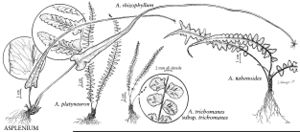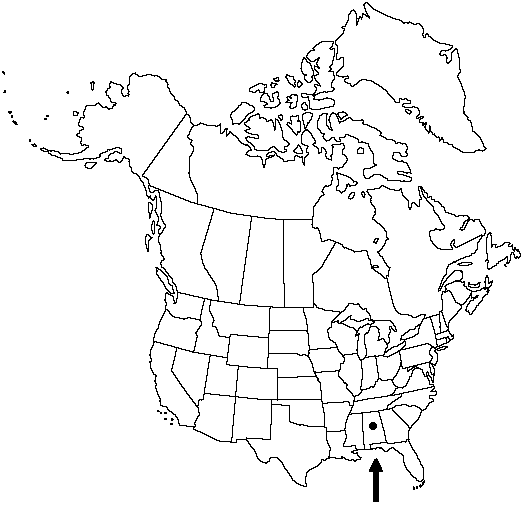Difference between revisions of "Asplenium ebenoides"
Gard. Monthly & Hort. Advertiser 7: 267. 1865.
FNA>Volume Importer |
imported>Volume Importer |
||
| (7 intermediate revisions by 2 users not shown) | |||
| Line 8: | Line 8: | ||
}} | }} | ||
|common_names=Scott's spleenwort | |common_names=Scott's spleenwort | ||
| + | |special_status={{Treatment/ID/Special_status | ||
| + | |code=F | ||
| + | |label=Illustrated | ||
| + | }}{{Treatment/ID/Special_status | ||
| + | |code=E | ||
| + | |label=Endemic | ||
| + | }} | ||
|basionyms= | |basionyms= | ||
|synonyms={{Treatment/ID/Synonym | |synonyms={{Treatment/ID/Synonym | ||
|name=Asplenosorus ebenoides | |name=Asplenosorus ebenoides | ||
|authority=(R. R. Scott) Wherry | |authority=(R. R. Scott) Wherry | ||
| + | |rank=species | ||
}} | }} | ||
|hierarchy=Aspleniaceae;Asplenium;Asplenium ebenoides | |hierarchy=Aspleniaceae;Asplenium;Asplenium ebenoides | ||
| Line 20: | Line 28: | ||
}}<!-- | }}<!-- | ||
| − | --><span class="statement" id="st- | + | --><span class="statement" id="st-undefined" data-properties=""><b>Roots </b>not proliferous. <b>Stems</b> ascending to erect, rarely branched; scales dark brown to blackish throughout, narrowly deltate, 2–4 × 0.25–0.45 mm, margins entire. <b>Leaves</b> weakly subdimorphic, fertile leaves taller and more erect than sterile leaves. <b>Petiole</b> reddish or purplish brown throughout, lustrous, 1–10 cm, 1/5–1 times length of blade; indument of dark brown to black scales, narrowly deltate at very base, grading into hairs distally. <b>Blade</b> highly variable and typically irregularly shaped, narrowly deltate to lanceolate, pinnatifid or 1-pinnate in proximal 1/3, 2–20 × 1–6(–13) cm, medium thick, sparsely pubescent adaxially only; base ± truncate; apex acute to long-attenuate, apical buds borne occasionally but not known to root in nature. <b>Rachis</b> reddish or purplish brown abaxially, fading to green distally, lustrous, glabrous. <b>Pinnae</b> in 0–3 pairs, often irregular in size and shape, deltate to narrowly deltate; proximal pinnae 5–30(–80) × 3–10(–15) mm; base truncate to obtuse, auriculate on both sides; margins entire to finely serrate or crenulate; apex obtuse to acute or occasionally attenuate. <b>Veins</b> somewhat evident, mostly free, rarely anastomosing. <b>Sori</b> 1–10(–15+) pairs per pinna, on both acroscopic and basiscopic lobes. <b>Spores</b> malformed (sterile form) or 64 per sporangium (fertile form). <b>2n</b> = 72, 144.</span><!-- |
-->{{Treatment/Body | -->{{Treatment/Body | ||
| Line 26: | Line 34: | ||
|elevation=70 m | |elevation=70 m | ||
|distribution=Ala. | |distribution=Ala. | ||
| − | |discussion=<p>The above description applies to the sterile hybrid Asplenium platyneuron × rhizophyllum and its allopolyploid derivative. The allotetraploid form is known only from Hale County, Alabama, where it occurs with A. platyneuron (but not with A. rhizophyllum) on conglomerate boulders (K. S. Walter et al. 1982). The sterile diploid form of A. ebenoides occurs at elevations of 70 to 500 m within the region where the ranges of the parental species overlap, always occurring with both parents on limestone, sandstone, or other rock strata. A hybrid between the allopolyploid and A. platyneuron [A. × boydstoniae (K. S. Walter) J. W. Short] was discovered at Havana Glen. An unnamed hybrid between the sterile diploid (presumably via unreduced spores) and A. rhizophyllum is known from West Virginia and Missouri (K. S. Walter et al. 1982).</p><!-- | + | |discussion=<p>The above description applies to the sterile hybrid <i>Asplenium platyneuron</i> × rhizophyllum and its allopolyploid derivative. The allotetraploid form is known only from Hale County, Alabama, where it occurs with <i>A. platyneuron</i> (but not with <i>A. rhizophyllum</i>) on conglomerate boulders (K. S. Walter et al. 1982). The sterile diploid form of <i>A. ebenoides</i> occurs at elevations of 70 to 500 m within the region where the ranges of the parental species overlap, always occurring with both parents on limestone, sandstone, or other rock strata. A hybrid between the allopolyploid and <i>A. platyneuron</i> [A. × boydstoniae (K. S. Walter) J. W. Short] was discovered at Havana Glen. An unnamed hybrid between the sterile diploid (presumably via unreduced spores) and <i>A. rhizophyllum</i> is known from West Virginia and Missouri (K. S. Walter et al. 1982).</p><!-- |
--><p>This fern has been pivotal in the study of fern hybridization. Called the "most famous hybrid fern," it was one of the first crosses to be synthesized deliberately in culture (M. Slosson 1902) and the first to be converted from the sterile diploid state to the fertile tetraploid state experimentally (W. H. Wagner Jr. and R. S. Whitmire 1957).</p> | --><p>This fern has been pivotal in the study of fern hybridization. Called the "most famous hybrid fern," it was one of the first crosses to be synthesized deliberately in culture (M. Slosson 1902) and the first to be converted from the sterile diploid state to the fertile tetraploid state experimentally (W. H. Wagner Jr. and R. S. Whitmire 1957).</p> | ||
|tables= | |tables= | ||
| Line 36: | Line 44: | ||
-->{{#Taxon: | -->{{#Taxon: | ||
name=Asplenium ebenoides | name=Asplenium ebenoides | ||
| − | |||
|authority=R. R. Scott | |authority=R. R. Scott | ||
|rank=species | |rank=species | ||
| Line 49: | Line 56: | ||
|publication title=Gard. Monthly & Hort. Advertiser | |publication title=Gard. Monthly & Hort. Advertiser | ||
|publication year=1865 | |publication year=1865 | ||
| − | |special status= | + | |special status=Illustrated;Endemic |
| − | |source xml=https:// | + | |source xml=https://bitbucket.org/aafc-mbb/fna-data-curation/src/2e0870ddd59836b60bcf96646a41e87ea5a5943a/coarse_grained_fna_xml/V2/V2_341.xml |
|genus=Asplenium | |genus=Asplenium | ||
|species=Asplenium ebenoides | |species=Asplenium ebenoides | ||
| − | |||
| − | |||
| − | |||
| − | |||
| − | |||
| − | |||
| − | |||
| − | |||
| − | |||
| − | |||
| − | |||
| − | |||
| − | |||
| − | |||
| − | |||
| − | |||
| − | |||
| − | |||
| − | |||
| − | |||
| − | |||
| − | |||
| − | |||
| − | |||
| − | |||
| − | |||
| − | |||
| − | |||
| − | |||
| − | |||
| − | |||
| − | |||
| − | |||
| − | |||
| − | |||
| − | |||
| − | |||
| − | |||
| − | |||
| − | |||
| − | |||
| − | |||
| − | |||
| − | |||
| − | |||
| − | |||
}}<!-- | }}<!-- | ||
-->[[Category:Treatment]][[Category:Asplenium]] | -->[[Category:Treatment]][[Category:Asplenium]] | ||
Latest revision as of 20:22, 5 November 2020
Roots not proliferous. Stems ascending to erect, rarely branched; scales dark brown to blackish throughout, narrowly deltate, 2–4 × 0.25–0.45 mm, margins entire. Leaves weakly subdimorphic, fertile leaves taller and more erect than sterile leaves. Petiole reddish or purplish brown throughout, lustrous, 1–10 cm, 1/5–1 times length of blade; indument of dark brown to black scales, narrowly deltate at very base, grading into hairs distally. Blade highly variable and typically irregularly shaped, narrowly deltate to lanceolate, pinnatifid or 1-pinnate in proximal 1/3, 2–20 × 1–6(–13) cm, medium thick, sparsely pubescent adaxially only; base ± truncate; apex acute to long-attenuate, apical buds borne occasionally but not known to root in nature. Rachis reddish or purplish brown abaxially, fading to green distally, lustrous, glabrous. Pinnae in 0–3 pairs, often irregular in size and shape, deltate to narrowly deltate; proximal pinnae 5–30(–80) × 3–10(–15) mm; base truncate to obtuse, auriculate on both sides; margins entire to finely serrate or crenulate; apex obtuse to acute or occasionally attenuate. Veins somewhat evident, mostly free, rarely anastomosing. Sori 1–10(–15+) pairs per pinna, on both acroscopic and basiscopic lobes. Spores malformed (sterile form) or 64 per sporangium (fertile form). 2n = 72, 144.
Habitat: Conglomerate boulders
Elevation: 70 m
Discussion
The above description applies to the sterile hybrid Asplenium platyneuron × rhizophyllum and its allopolyploid derivative. The allotetraploid form is known only from Hale County, Alabama, where it occurs with A. platyneuron (but not with A. rhizophyllum) on conglomerate boulders (K. S. Walter et al. 1982). The sterile diploid form of A. ebenoides occurs at elevations of 70 to 500 m within the region where the ranges of the parental species overlap, always occurring with both parents on limestone, sandstone, or other rock strata. A hybrid between the allopolyploid and A. platyneuron [A. × boydstoniae (K. S. Walter) J. W. Short] was discovered at Havana Glen. An unnamed hybrid between the sterile diploid (presumably via unreduced spores) and A. rhizophyllum is known from West Virginia and Missouri (K. S. Walter et al. 1982).
This fern has been pivotal in the study of fern hybridization. Called the "most famous hybrid fern," it was one of the first crosses to be synthesized deliberately in culture (M. Slosson 1902) and the first to be converted from the sterile diploid state to the fertile tetraploid state experimentally (W. H. Wagner Jr. and R. S. Whitmire 1957).
Selected References
None.

